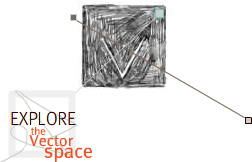Malperception
Author's Statement
Most of us take visual perception for granted. We assume that vision is just like a camera, at each instant taking a picture of the world that shows it pretty much as it is. As long as we have two (or at least one) functioning eyes, we can simply open them up and see the world. However, in the case of many visual disorders, there turns out to be absolutely nothing wrong with the sufferer's eyes, and thus they can "see" as well as any of us. Instead, it is their ability to make sense of what they see that has become damaged or lost. The process of the eye's cornea focusing photons of light onto the rods and cones of the retina is, in fact, only the very first stage of visual perception.
Remarkably, about half of the brain's cortex is engaged in vision: roughly fifty billion neurons and ten trillion synapses are engaged each time you open your eyes and glance around. If vision was really just like a camera, this computational power would be overkill. Research in the cognitive neurosciences has revealed that the visual system is more like a reality engine, constructing with astonishing quickness all the shapes, colors, objects, motions and depths that we see. Damage to this reality engine can profoundly impair our ability to construct the visual world, leading to a variety of bizarre visual deficits, ranging from an inability to recognize faces or see objects to various crippling failures to properly construct a three-dimensional world. Reflecting on the remarkable ways that the visual system can malfunction can give us insight into the actual nature of perception; each disorder shines a spotlight on some unexpected aspect of visual perception.
In Malperception, the two of us - a cognitive science and an artist - joined forces in an attempt to visualize breakdowns in visual perception - a task that is inherently self-contradictory. Thus, it is probably inevitable that this project would be a mix of fact, speculation, and fiction. We chose a baker's dozen of visual disorders, and present each - through graphics, text and sound - to encourage users to enter into the specific altered world experienced by a sufferer of this neurological condition. We hope that the experience of these worlds - in which nothing can be taken for granted - may ultimately cause users to question their own perceptions.



